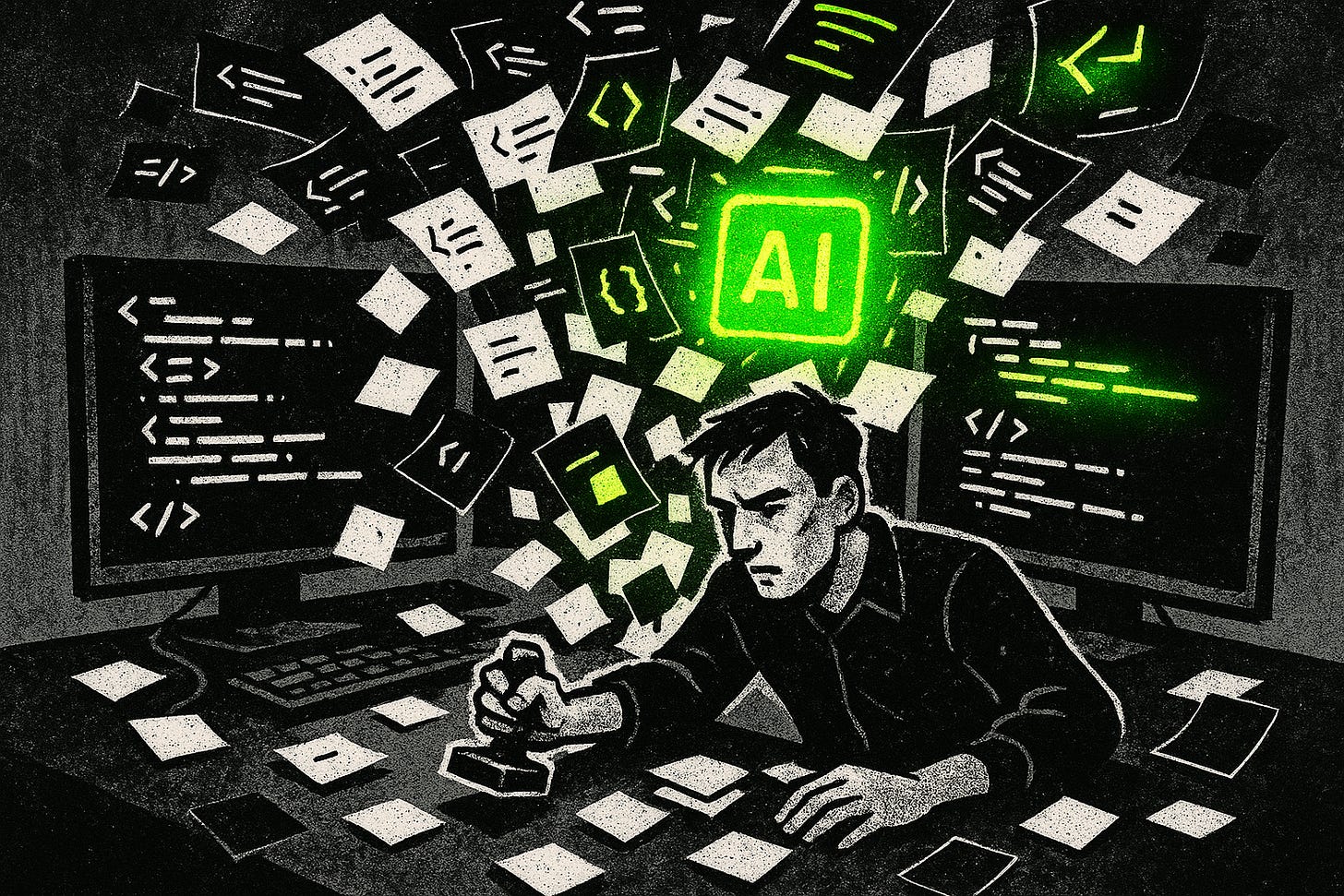The Promotion You Never Wanted
AI gave you management duties. HR forgot the raise.
Six months ago
The headline was everywhere: “AI will write 90% of code within half a year.”
Everyone had a take. Some cheered the revolution. Others declared the profession dead. Some said it would rot your brain. Others promised infinite productivity.
Flip a coin. You’d land on a loud opinion.
Here’s the truth: I’ve lived with AI in production for more than six months. Banking features. Infra. Real outages. Security holes. Audits. Money on the line.
And what I’ve learned is simple: developers aren’t obsolete. They’ve been promoted. Against their will.
What changed
The keyboard isn’t the bottleneck anymore. Typing is cheap. AI will scaffold the CRUD, draft the Terraform, spit out 10,000 lines of plausible code while you eat lunch.
The bottleneck is judgment. The job is ownership.
Did you review intent, not just syntax?
Did you notice the skipped constraint before it cost the client their license?
Did you catch the overconfident garbage before it hit prod?
You don’t own the lines you type anymore. You own the blast radius of what you approve.
The flood
Here’s the fatigue part nobody warns you about.
Humans bury you in 5 PRs a week. AI buries you in 50.
Every one looks right at a glance. Most are 80–95% correct. The same hit rate I expect from a junior. But at scale.
That’s why people complain about “review fatigue.” It’s not that AI is worse. It’s that it produces the same mistakes faster. You drown in almost-right code until you stop reading carefully—or you miss the one that matters.
I missed one. Terraform config. Looked fine. Passed validation. Except it silently skipped a constraint and opened a regulated system to the world. Alerting caught it. But it was still my responsibility.
The rules don’t change
People keep drafting 60-slide “AI governance frameworks.” Forget it. The rules are the same ones we should’ve been enforcing on humans:
Juniors don’t merge to prod. Neither does AI.
Review logic, not commas.
Automate the gauntlet: lint, tests, CI/CD, security scans.
Pair AI with a human, don’t replace. AI + junior beats either alone.
Define “done.” If you don’t, AI will invent it.
Own the blast radius. “The AI did it” dies in audit.
AI isn’t alien. It’s just infinite juniors with no shame and no fatigue. Manage them the same way.
The job spec you didn’t want
Developers used to measure output in lines typed. Now it’s decisions approved.
Less builder. More reviewer.
Less typing. More triage.
Less “I made this.” More “I take responsibility for this.”
That’s management. From day one.
And like every manager, you inherit fatigue. The flood of almost-right. The uncertainty of never being sure you caught everything. The knowledge that when it goes wrong, it’s your name on the blast radius.
Welcome to management.
The illusion of training
I had a junior spend a fortune on a dev bootcamp. His capstone CRUD app took two weeks. A good effort. Classic rite of passage.
We rebuilt it with Claude and v0 in ~20 minutes.
That’s not a dunk on him. It’s a signpost. The point of training isn’t syntax anymore. It’s judgment. It’s learning to specify well, to define “good enough,” and to own outcomes. And as such it requires a different kind of training.
Approve → improve → ship. That’s the real job.
Why it hurts
The loudest complaint you hear—“AI is almost right, but not quite”—isn’t about AI. It’s about the new job description.
You’re feeling what managers felt all along. The fatigue of endless output you can’t fully parse. The anxiety of decisions under uncertainty. The pressure of ownership without control.
Developers didn’t get replaced. They got promoted into exactly that. Overnight.
The verdict
Six months in, I’ll tell you what I know:
AI writes the code.
I own the mistakes.
The bottleneck is judgment.
The cost is ownership.
That’s the deal.
The code is Claude’s.
The breach is mine.
It’s the promotion nobody asked for. Take it every time.


